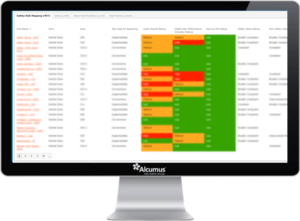Safety Tech
Safety at scale with Sainsbury’s and Alcumus
Neil Lennox, Group Head of Safety and Insurance at Sainsbury’s, speaks to John Kersey about the company’s collaborative partnership with EHS software providers Alcumus Info Exchange and how it approaches safety at scale.

According to its last annual report, Sainsbury’s run over 608 supermarkets, 815 convenience stores, 639 Argos stores, plus 205 additional Argos stores, either inside Sainsbury’s or Homebase, 16 Habitat Stores, 27 Deports and 12 Store Support Centres, totalling over 2,300 locations. On top of over 185,000 work colleagues, this amounts to a lot of risk to track and manage.
Neil, can you tell us something about the background on your partnership with Alcumus?

Neil Lennox (NL): “We have been working with Alcumus for over 15 years and have accumulated a wealth of data both on individual sites and for the business as a whole including near misses, incidents, injuries, enforcement contacts and visit reports, as well as cultural measures – a safety index we generate from our annual employee surveys. About four years ago our team, including our field-based teams, was reorganised which meant that individuals had to cover up to 260 sites each, so we needed a means to prioritise where to spend time. We also wanted to look at both lagging and leading indicators to create a Safety Risk Map, which we started about three years ago and has been running live for two years now. It uses the Alcumus Info Exchange software, specifically the Risk Map module which was tailored to our requirements. This imports data from a variety of sources including Info Exchange and Excel spreadsheets into the enterprise software, providing a straightforward centralised dashboard.”
What was Sainsbury’s approach, key objectives and how did you decide to go about it?
(NL): “We looked at a range of KPIs including fire alarm checks, legal training and site visit reports. The data was gathered in web-based forms with weighted factors behind these. These were compiled into a compliance risk measure which also included issues from other areas such as pest control, claims and security. At the next level there are risk factors such as cleaning, legal measures and allergen information. These are summarised into a dashboard with five key measures with individual stores having an overall rating. We find the supermarkets are generally higher risk when compared to the lower risk Argos stores. This is a dynamic tool that we are able to use at the quarterly Group Safety Meeting, helping to streamline the review process.

“The online dashboard helps provide regional managers with specific factors to look at and offers a more targeted focus area to take action on. Backing this up is a risk app that highlights results from daily and weekly checks. For example, the Store Risk Map data supports Sainsbury’s drive on certain topics such as Think 25 (age checks before selling alcohol and tobacco products) and striving to have 100% 5* Food Hygiene Rating visits.”
How did your implementation strategy work out?
(NL): “Because the software is dynamic, and we see changes as data is uploaded, we found it particularly useful collating all the data into one place and rolling this up into the store risk factor. Due to the amount of data we were initially receiving, we worked closely with the Alcumus Info Exchange team to determine the biggest factors to help refine the information. For our risk factors we look at the compliance measures that affect our stores the most, such as code control, compliance with our underage sales processes and cleaning. As a live example, one issue here is the sale of knives which, in the light of an increase in knife crime, led to a review of our policy. A decision was made to stop selling knives within certain stores where higher knife crime was reported.”
What were the problems arising and how were they overcome?
(NL): “There were some inevitable challenges around data crunching given there are over one million calculations required to maintain the system. To address this, we changed to a weekly run routine every Saturday to help ensure the information was more manageable and sustainable. We also found it necessary to pitch the weighting on factors at the right level. This was a process of trial and error which required some tweaking over time until we got the balance right.
“We recognise we have taken on quite a sizeable piece of software and now need a steady state to let it settle down. We have found stores are scoring the same so also need to look at re-weighting the questions to identify useful trends.”
What do you consider were the insights and benefits arising from the project?
(NL): “Our operations team really love the predictive level of the intelligent data. Also, our due diligence checks benefit from the data yielded from thousands of site visits. The centralised data allows the visits to be much more tailored, making each visit extremely valuable. As the stores are rated either Red, Amber or Green, operational staff can easily see areas that need improving. We can now tailor site visit questions to focus on the particular issues identified at that store. This also leads to regulator buy-in.
“We have undertaken a pilot study with the Food Standards Agency (FSA) using the Risk Map information to prioritise and validate visits. This has the potential to save up to four hours per EHO visit in a Supermarket where the store doesn’t warrant a visit due to its low risk scoring. This leads to an assured and rational approach to compliance, rather than one based on gut feel or convenience. It also allows the FSA to re-deploy staff on visits to other high priority sites. It is a win-win for both parties.
“Our enforcement action position is in a much better place now with the increased transparency and assurance the system has brought us all.”
Disclaimer. The views expressed in this article are those of the author and do not necessarily represent those of any commercial, academic or professional institution I am associated with. Mention of a specific product or service does not necessarily equal endorsement.
See Neil speak at Safety & Health Expo
Neil Lennox will be delivering a seminar, entitled ‘
Case study and demo: Predictive analytics & risk – using data‘ at
Safety & Health Expo 2019, taking place at London’s ExCeL from 18-20 June.
Sainsbury’s has been working with Alcumus Info Exchange over a number of years to take the business and safety data available and feed this into a “Risk Map” for all of its 2,000+ stores. The aim is to try to predict where issues are likely to occur before they do. The company has also piloted this as part of a National Inspection strategy Approach with the Food standards Agency. In his talk, Neil will explain how the company approached this, what it has seen so far and how he sees this developing further.
WATCH: Safety & Health Event Director Chris Edwards discuss the new Safety Tech Zone at Safety & Health Expo 2019, where there will be demonstrations of the most innovative pieces of technology that are having an impact on health and safety.
Click below to secure your free ticket.
Safety at scale with Sainsbury’s and Alcumus
Neil Lennox, Group Head of Safety and Insurance at Sainsbury’s, speaks to John Kersey about the company’s collaborative partnership with EHS software providers Alcumus Info Exchange and how it approaches safety at scale.
John Kersey
SHP - Health and Safety News, Legislation, PPE, CPD and Resources Related Topics
Drug and alcohol testing in a UK airport environment
Unleashing the power of emerging technologies in EHS
Passing the baton – Meet the 2024 IOSH President




Neil could do with looking hard at the Health and Safety compliance within the stores, with H.R. limiting PPE, managers running shifts with insufficient staff often leading them to leave frozen foodstuffs outside of freezers to defrost and attacked by the rats that seem to infest the van delivery yard and back of store areas.